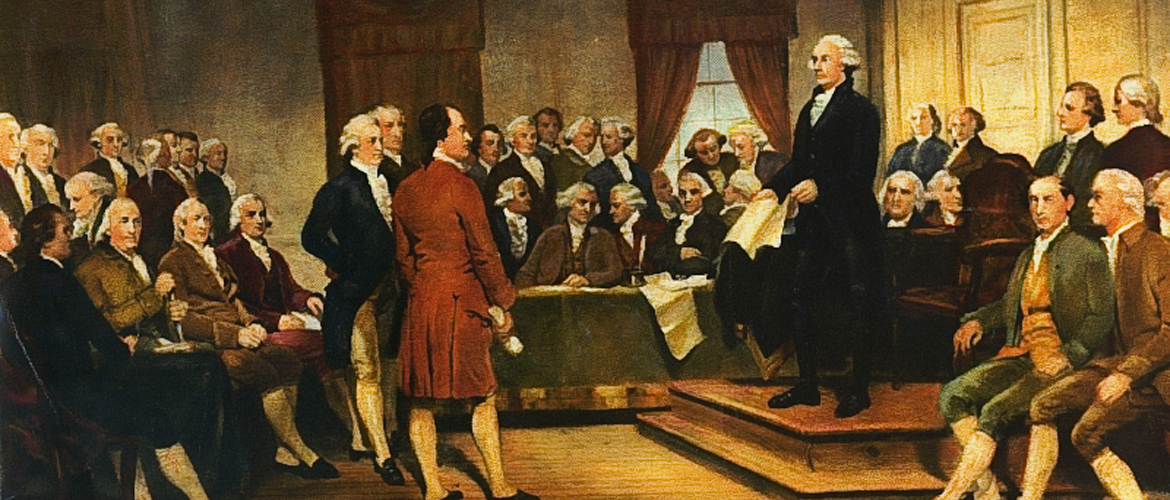 If there was one battle cry that defined the 1960s it had to be “Question Authority.” It seemed to be our raison d’ être, in part because we got to define who or what authority was.
If there was one battle cry that defined the 1960s it had to be “Question Authority.” It seemed to be our raison d’ être, in part because we got to define who or what authority was.
Well, it might be time to drag out those bell-bottom jeans with the American flag patches on the seat and dust off the old rallying cry.
It seems while we were busy questioning the war, the justice system, and whether you could cry “sex” in a crowded theater we missed the granddaddy of all opportunities. If you think Hamilton portrays the Constitutional Convention as all song and dance it’s nothing like the real show.
Since March 21, 1788, the day the Constitution was ratified, it’s never actually been ratified.
The changes the states were asked to approve included a contradiction of the rules the states were supposed to follow to approve any changes to the rules. Forget it. It’s easier to understand Einstein’s Theory of Relativity.
“There are a number of reasons you can suggest the Constitution is illegal,” according to Dr. John Vile, author, professor of political science, and dean of the University Honors College at Middle Tennessee State University. “The one that stands out is that under the Articles of Confederation, you had to have 13 states ratify any amendments, and only 12 states even attended the convention.”
What many people overlook is that the Constitutional Convention wasn’t convened to write a new constitution. Its commission was, in Dr. Vile’s words, “to enlarge and correct the Articles of Confederation.”
But when the delegates heard what’s known as the Virginia plan—which introduced the concepts of three branches of government and a bicameral legislature—they decided not only to rewrite the Articles, but history as well.
“Under the Articles of Confederation, primary power was exercised by the state legislatures,” Dr. Vile noted. Those legislators were the men behind the curtain of government. And they had the most to lose once the new constitution was ratified, because most of their power would be shifted to a federal government.
“The Convention probably exceeded the commission it had received from Congress,” said Dr. Vile, referring to the decision to rewrite the Articles instead of making cosmetic changes.
When the document was sent on to the states—without the formal approval by Congress required by the Articles of Confederation—Article VII of the proposed constitution contained the rules for its own ratification.
One rule substituted state ratifying conventions for the state legislatures.
“The Massachusetts constitution of 1780, which is actually the oldest written constitution that I know of that’s continually functioning, sort of set the stage,” Dr. Vile said, referring to the use of these ratifying conventions.
“At the time, those in government did not make much of a distinction between popular sovereignty and a convention. A ratifying convention was considered to be the voice of the people,” he said.
The conventions afforded a way of tap dancing around those legislators who chose to be tone deaf. Their most desirable quality? Ratifying conventions allowed only an up or down vote. No grandstanding for the folks back home by insisting that some comma needed to be replaced by a semicolon.
And, according to Article VII, only nine of the 13 ratifying conventions had to vote aye for the new constitution to go into effect.
That was, perhaps, the best piece of stagecraft at the Constitutional Convention.
Remember, the Articles required unanimous consent to make any changes. The changes the states were asked to approve included a contradiction of the rules the states were supposed to follow to approve any changes to the rules.
Forget it. It’s easier to understand Einstein’s Theory of Relativity.
All you need to know is that yes, the Constitution is technically illegal and no, marching through the streets won’t bring the Articles of Confederation back.
“I don’t have a law degree, but I do know that if a family has been inhabiting a piece of land for 200 or 300 years, it’s theirs. It doesn’t matter whether there were any defects in the original acquisition. I think that would probably apply here.”
As Dr. Vile was quick to note that although the Constitution went into effect when ratified by nine or more states, it only went into effect in those states that ratified it.
Since the Constitution’s initial ratification, however, all 13 states have voted aye. “And every time a state joins the Union it comes in with the understanding that it’s approving the Constitution,” he added.
While it might be a little late I did have the thought that, technically, Los Angeles has no authority to issue that parking ticket I got last week until the 13 original states approve the Constitution’s ratification procedures.
I suspect Dr. Vile would tell me to put my bell-bottoms back in the closet.
Start your Sunday with a laugh. Read the Sunday Funnies, fresh humor from The Out Of My Mind Blog. Subscribe now and you'll never miss a post.
Since 2009, Dr. John Vile has served as as Dean of the University Honors College at Middle Tennessee State University (MTSU). He is a scholar of the U.S. constitutional amending process as well as a prolific author who has written and edited numerous books, essays, chapters, and reviews on this and related topics. He received the MTSU Foundation Distinguished Research Award in both 1993 and 1999 and the Career Achievement Award in 2011. The American Mock Trial Association awarded him the Congressman Neal Smith Award in 2000 for outstanding contributions to legal education and named him to the Coaches Hall of Fame in 2008. Prior to serving as Dean, Dr. Vile was Chair of the Department of Social Sciences at McNeese State University and Chair of the Department of Political Science at MTSU. A graduate of the College of William and Mary, he earned his Ph.D. in Government from the University of Virginia. Dr. Vile is a member of Phi Beta Kappa, Omicron Delta Kappa, and Phi Kappa Phi.
Mind Doodle…
In Article 1, Section 10 of the Constitution, the use of word “it’s” is incorrect. The correct word is “its.” Probably enough for William Kuntsler to have gotten the whole Constitution tossed out of court. If only we’d known.

Huh? Are we not a legal country?
Hi Nancy…
I think, by extension, this also means we’re all born out of wedlock.
— jay